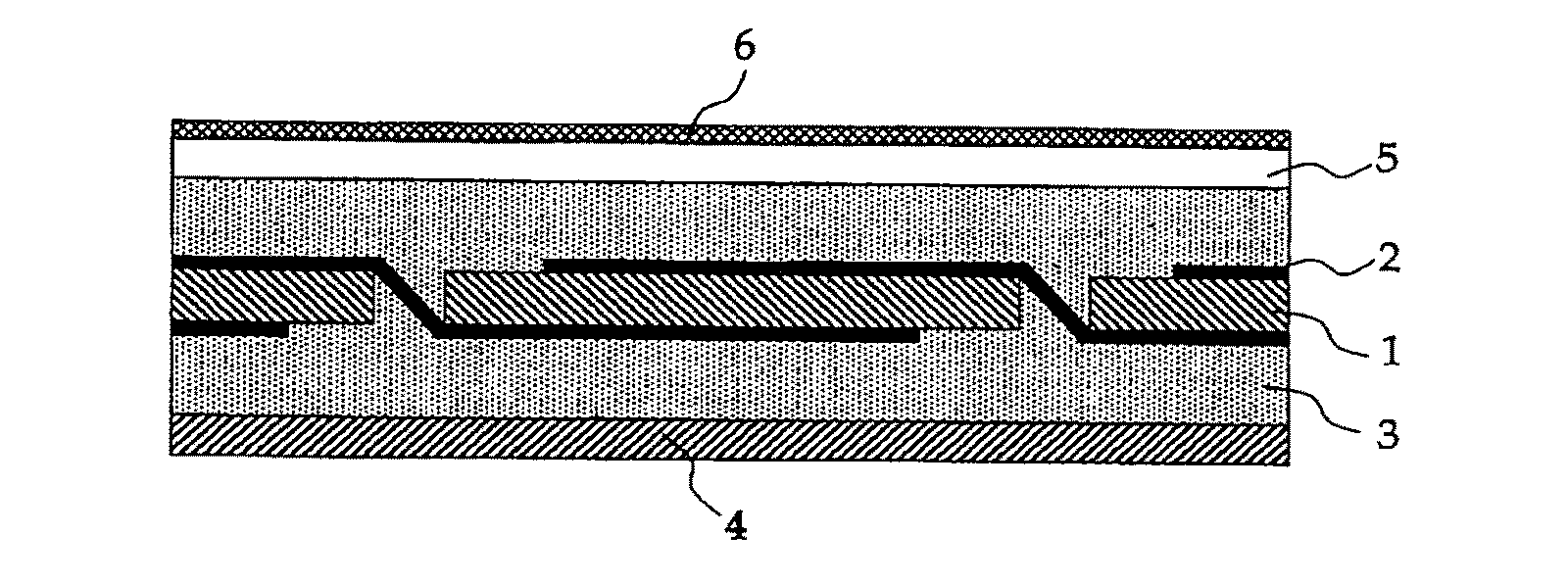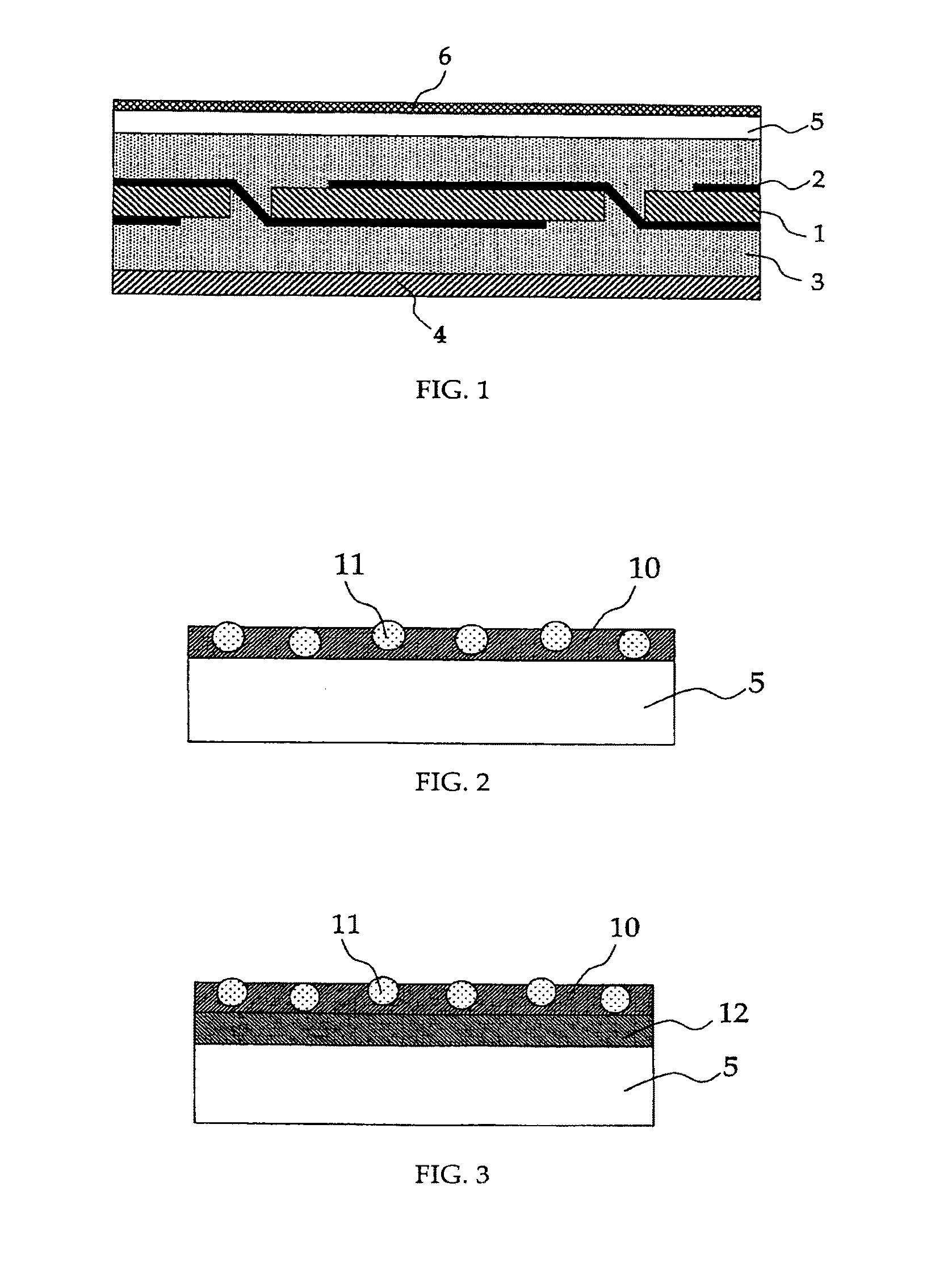Coating agent for solar cell module, and solar cell module and production method for the solar cell module
a solar cell module and coating agent technology, applied in the direction of coatings, pv power plants, material nanotechnology, etc., can solve the problems of disadvantageous use of thin films as anti-reflection films of solar cell modules, high cost of resin itself, etc., and achieve excellent photoelectric conversion efficiency, excellent reflectance-reducing effect, and excellent abrasion resistance and weather resistance
- Summary
- Abstract
- Description
- Claims
- Application Information
AI Technical Summary
Benefits of technology
Problems solved by technology
Method used
Image
Examples
embodiment 1
[0024]A coating agent for a solar cell module of this embodiment (hereinafter, merely referred to as “coating agent”) is obtained by dispersing silica fine particles (A) and low-refractive index resin particles (B) in an aqueous medium.
[0025]The silica fine particles (A) form a porous silica film when the coating agent is applied and dried. The silica film is transparent because of the presence of minute voids. Further, as the refractive index of the silica film is as low as that of the low-refractive index fine particles (B) (refractive index of SiO2: 1.45, refractive index of a silica film with a porosity of 20%: about 1.35), it is possible to decrease the refractive index of the coating film (anti-reflection film) formed by the coating agent.
[0026]The average particle diameter of the silica fine particles (A) is 15 nm or less, preferably 12 nm or less, and more preferably 4 nm to 10 nm, when they are dispersed in water and measured by a dynamic light scattering method. Due to the...
embodiment 2
[0059]A solar cell module of this embodiment has an anti-reflection film formed of the above-mentioned coating agent on the surface on a light-receiving surface side.
[0060]Hereinafter, an example of the solar cell module of this embodiment is described with reference to the drawings.
[0061]FIG. 1 is a cross-sectional view of a basic structure of the solar cell module of this embodiment. In FIG. 1, the basic structure of the solar cell module includes a plurality of solar cells 1 arranged at a predetermined interval, wires 2 connecting the plurality of solar cells 1, a transparent resin 3 sealing all of the solar cells 1 and wires 2, protective glass 5 formed on the transparent resin 3 on a light-receiving surface side, a protective film 4 formed on the transparent resin 3 on an opposite side, and an anti-reflection film 6 formed on the protective glass 5. Then, an end of the basic structure is framed with an aluminum frame or the like (not shown).
[0062]A solar cell module having such...
embodiment 3
[0073]According to a method of producing a solar cell module of this embodiment, the anti-reflection film 6 is formed at room temperature using the above-mentioned coating agent.
[0074]In the case of forming the anti-reflection film 6 having the construction of FIG. 2, it is sufficient that the above-mentioned coating agent is applied onto the surface of the solar cell module on a light-receiving surface side (that is, the protective glass 5), and is then dried at room temperature and a predetermined airstream speed.
[0075]The method of applying the coating agent is not particularly limited, and any known method may be used. Examples of the applying method include spraying, roll coating, soaking, and flowing.
[0076]The applied coating agent is dried at a predetermined airstream speed from the viewpoints of, for example, preventing the occurrence of a non-uniform thickness and enhancing the dispersibility of the low-refractive index resin particles (B) 11. The airstream that can be used...
PUM
| Property | Measurement | Unit |
|---|---|---|
| particle diameter | aaaaa | aaaaa |
| refractive index | aaaaa | aaaaa |
| particle diameter | aaaaa | aaaaa |
Abstract
Description
Claims
Application Information
 Login to View More
Login to View More - R&D
- Intellectual Property
- Life Sciences
- Materials
- Tech Scout
- Unparalleled Data Quality
- Higher Quality Content
- 60% Fewer Hallucinations
Browse by: Latest US Patents, China's latest patents, Technical Efficacy Thesaurus, Application Domain, Technology Topic, Popular Technical Reports.
© 2025 PatSnap. All rights reserved.Legal|Privacy policy|Modern Slavery Act Transparency Statement|Sitemap|About US| Contact US: help@patsnap.com


